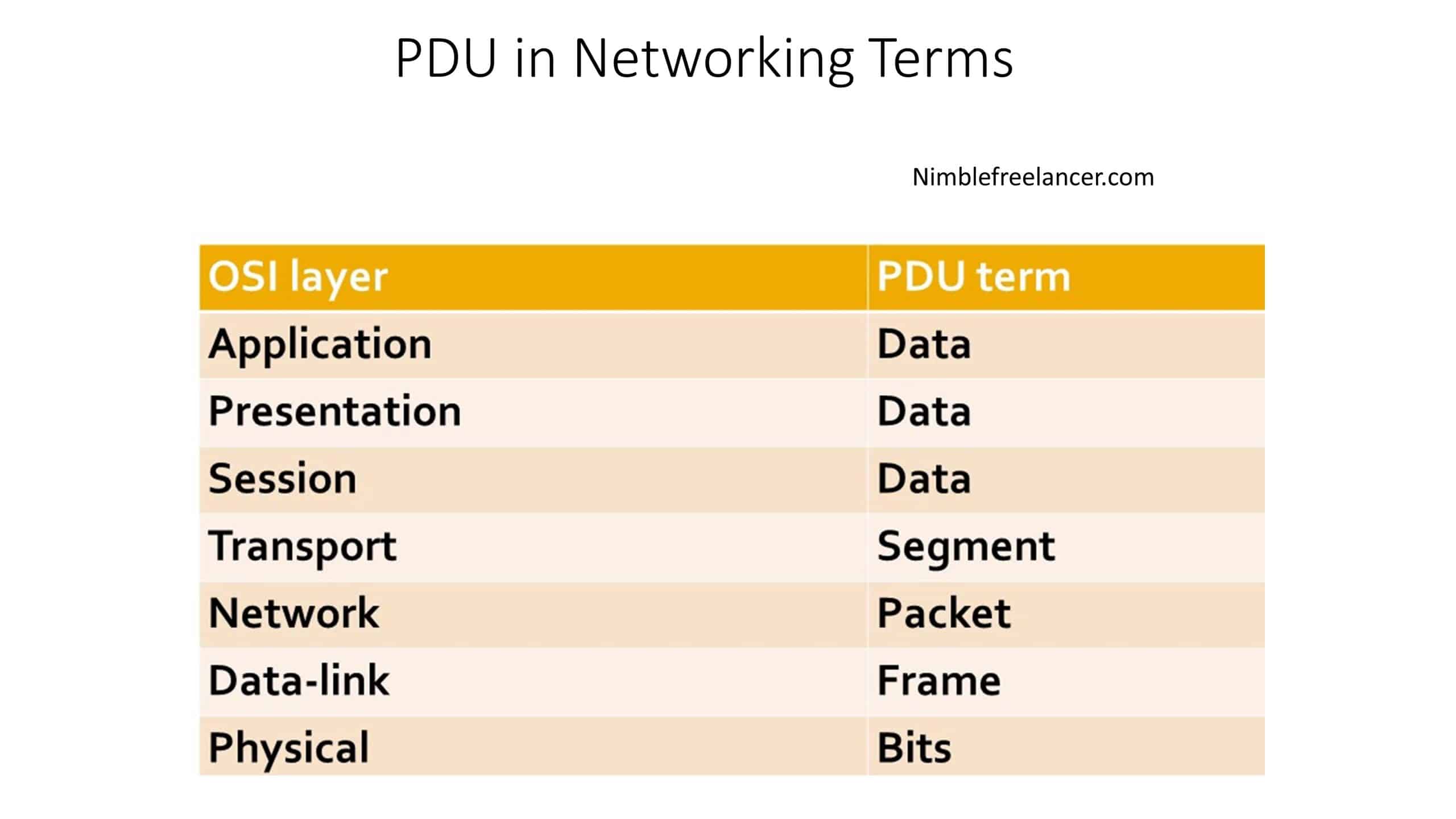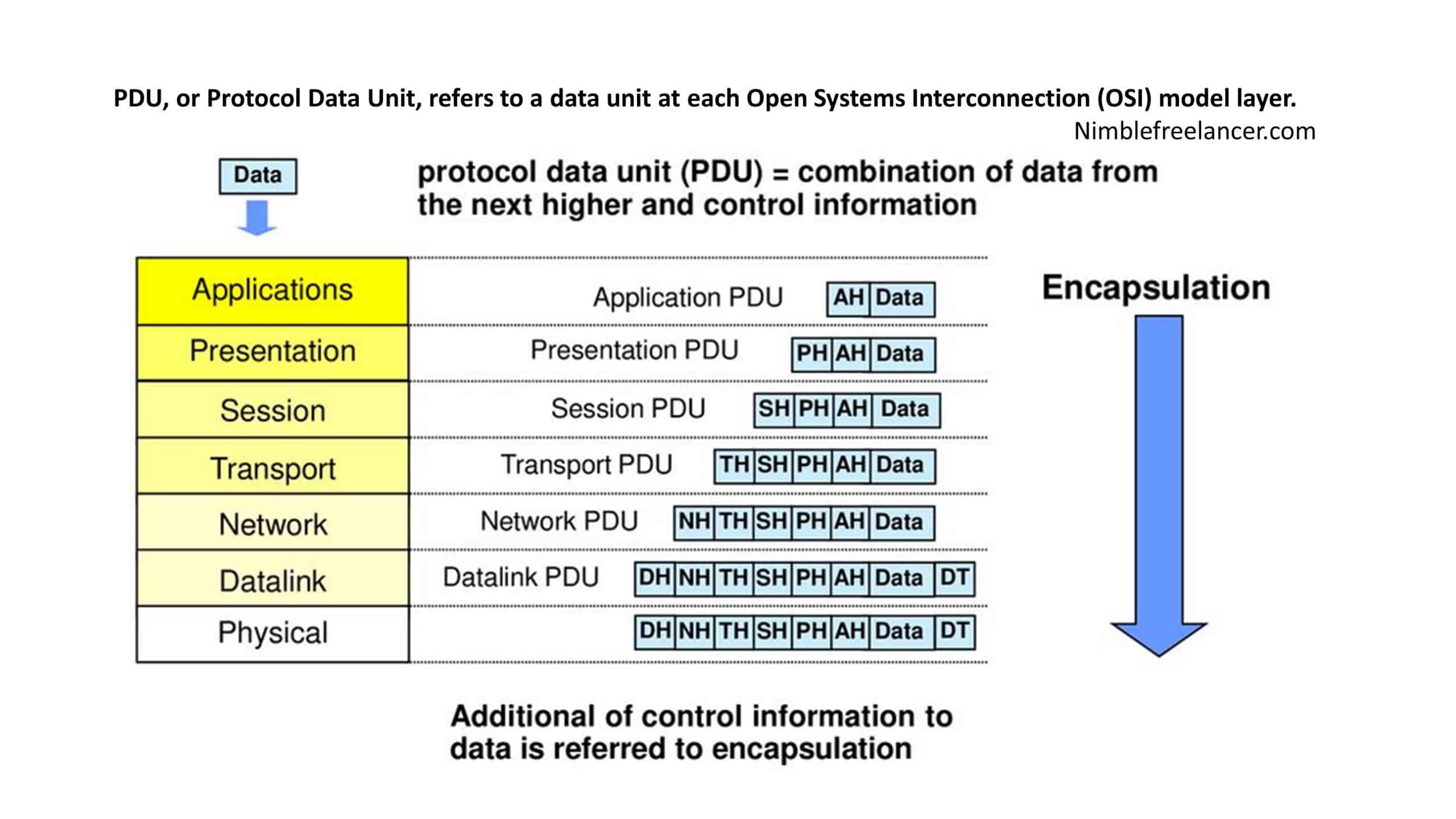The Data Processing Unit (Protocol data) is individually sent between computer system sensor hubs. For example, a network protocol unit (PDU) comprises document routing updates and personal information. When data link stacks are built on a blockchain system, each custom feature procedure is customized to the particular strain or data transfer method.
What is PDU in Networking?
A PDU or Protocol Data Unit (PDU) represents a single unit of information from a specific layer transferred over a computer network. As packaged data, a PDU comprises protocol-specific control information and user data. PDUs have been used in network closets, data centers, VoIP phone systems, and industrial environments.

PDU, or Protocol Data Unit, refers to a data unit at each Open Systems Interconnection (OSI) model layer. Therefore, eLayerayer in the model has a different PDU.

The OSI model is a conceptual framework that standardizes a network’s functions into distinct categories or layers. This makes it easier to understand network protocols and how they interact. The OSI model has seven layers, from the physical layer to the application layer.
At eLayerayer, the PDU represents the transmitted information and the necessary headers or trailers for tLayerayer. For example:
- Physical Layer (Layer 1): The PDU is, a bit, the most basic unit of data in computing.
- Data Link Layer (Layer 2): The PDU is a frame. A frame includes the raw bits, information about which computer sent the data, which computer should receive it, and error-checking data.
- Network Layer (Layer 3): The PDU is a packet. A packet includes the frame data and additional information like the source and destination IP addresses. Routers operate at tLayerayer.
- Transport Layer (Layer 4): The PDU is a segment (for TCP) or a datagram (for UDP). This PDU includes the packet data, information about the source and destination ports, and other data for reliable transmission (for TCP).
- Session Layer (Layer 5), Presentation Layer (Layer 6), and Application Layer (Layer 7): The PDU for these layers is often just referred to as data. However, these layers are more about controlling the session, translating data formats, and providing services directly to the user, so their PDUs don’t typically have unique names.
When a message is sent from one device to another over a network, it starts at the high layer on the sending device, gets wrapped in the necessary headers or trailers at eLayerayer, and is sent over the network. At the receiving device, the process is reversed, with eLayer’s headers or trailers being stripped off until the message reaches the high layer on the receiving device.
There are different “layers” through which the network functions and applications are delivered. For example, parts and zeroes can be sent across such a wire or fiber by the higher layers; pieces of data can be safely organized by the protocol stack and delivered to the given rights location on the cables; information chunks can be passed over numerous data devices by the protocol stack, and information can be provided to the proper implementation at the vacation spotLayerayer three.
What is a PDU called at the link layer?
The PDU at the link layer is called the frame. At the OSI model’s Data Link Layer (Layer 2), the Protocol Data Unit (PDU) is called a “frame.”
A frame encapsulates the network layer (Layer 3) data packet and includes additional information necessary for transmission. This extra information often includes:
- Source and Destination MAC addresses: These are unique identifiers for network interfaces. The source address identifies the sender, and the destination address identifies the recipient.
- Error Checking with a Frame Check Sequence (FCS): This is often a cyclic redundancy check (CRC) value that the receiving device uses to detect if the frame encountered any errors in transit.
- Start and End markers: These are sequences of bits that denote the beginning and end of the frame.
- EtherType (in Ethernet frames): This field specifies the protocol of the payload packet (for instance, IPv4 or IPv6).
- Payload: This is the actual data being transported, which, at tLayerayer, is typically a packet from the Network Layer (Layer 3).
The Data Link Layer is responsible for node-to-node communication and access to the physical media. Ethernet and Wi-Fi are examples of standards that operate at tLayerayer and use frames.
What is a metered PDU?
A Metering Power Distribution Unit (PDU) is a rack that monitors and distributes power to various devices, such as servers, switches, and routers in data centers and other networking environments. It provides real-time remote monitoring of connected loads and power utilization data to help Data Center Managers generate informed load-balancing decisions.
Here are some key features and functionalities of a Metered PDU:
- Power Monitoring: Metered PDUs have a built-in feature to monitor a total load of connected equipment in real time. They can display power usage information on a local LED display, usually in amps.
- Overload Prevention: These PDUs can help prevent circuit overload by constantly monitoring power usage. Alerts can be set up if power consumption approaches the maximum limit.
- Power Distribution: Metered PDUs distribute electric power to multiple outputs. They take control through a single input and distribute it to several outlets for different devices.
- Efficiency Management: They assist in managing power resources efficiently by providing precise information about power consumption. This can help balance loads and optimize energy usage in a data center.
- Device Placement Planning: Information from metered PDUs can help decide where to place new equipment within a rack or data center based on the available power capacity.
- Rack Environment Suitability: Most Metered PDUs are designed to be rack-mountable, fitting standard 19-inch server racks. This makes them suitable for use in data centers and server rooms.
- Outlet Number and Type Variety: Metered PDUs come in various configurations with different numbers and outlets (such as IEC or NEMA-type outlets) to suit other equipment and regional power standards.
While metered PDUs provide real-time power usage data, they usually do not have remote monitoring or outlet control features in switched or intelligent PDUs.
What process involves placing one PDU inside of another PDU?
Encapsulation is the process of placing one PDU inside another PDU. It usually occurs on networks when one data unit protocol is carried inside the data field of the next lower protocol data unit.
Yes, encapsulation is placing a Protocol Data Unit (PDU) inside another PDU. This happens in the context of the OSI (Open Systems Interconnection) model, which breaks down network communication into seven layers. Let’s discuss this concept in detail:
- What is encapsulation? Encapsulation is a networking process in which data from one protocol (the higLayerayer) is wrapped (encapsulated) within another protocol’s format (the loLayerayer) so it can be transported across the network safely and reliably.
- How does it work? For example, when you send an email, your message (data) first exists at the Application Layer (Layer 7 of the OSI model). Then, as it travels down the OSI layers to be sent across the network, eLayerayer adds its header (or, in some cases, a trailer) to the PDU from Layerayer above. This additional information allows the data to be interpreted and processed correctly by the correspondLayerayer on the receiving end.
- An Example: At the Transport Layer (Layer 4), the PDU is a segment (in TCP) or datagram (in UDP). This contains the data from the Application Layer and a header containing source and destination ports, sequence numbers, etc. This whole segment (or datagram) is then encapsulated into a packet at the Network Layer (Layer 3), with a new header added that includes source and destination IP addresses. This packet is then encapsulated into a frame at the Data Link Layer (Layer 2), adding information like source and destination MAC addresses. Finally, these frames are converted into bits at the Physical Layer (Layer 1) for transmission over the network medium.
- Decapsulation: The receiving device reverses this process, stripping away the headers or trailers at eLayerayer (called decapsulation), allowing it to understand and use the data as it ascends the OSI model.
- Benefits: Encapsulation allows complex data communication processes to be subdivided into manageable parts. ELayerayer of the OSI model can operate relatively independently, focusing on its specific function without being concerned with other layers’ specifics. This modularity is a significant reason for the resilience and adaptability of network communication protocols.
Which name is assigned to the transport layer PDU?
The transport layer PDU is assigned as the TCP segment for TCP and the datagram for UDP. The Internet layer PDU is the packet, while the link-layer PDU is the frame.
AS SEEN FROM THE COMPARISON, the OSI model’s program, presenting, and transaction levels are merged into a single server-side in the Protocol paradigm. Therefore, the transportation and communications layers will stay separate. At the network layer, TCP is active, while IP is active at the Internet protocol. In the TCP/IP architecture, the internet connectivity layer comprises the OSI base station and protocol stack.
A target host or connection is not identified in the PDU message layer. Instead, a program or application operating on the endpoint host controller would interact with the sent information. Even if they are Web consumers or administrators, it is possible for hosting to execute numerous computer networks at once. The application typically operates alongside a browser window, text messaging software, video streaming, and possibly even a gaming PC. Consider all of these independently executing applications as an illustration of a separate container. At least a single networking phase is initiated when you view a web browser.
Does a PDU have surge protection?
No, PDUs do not have surge protection. However, you can get more sophisticated strips with built-in surge protection, such as Cyberpower’s line of rack bars.
Domain names are added to segment response messages by the TCP protocol so that the network administrator understands which approval process should receive packets from the TCP protocol. The destination computer assigns different ports to different types of traffic. Over a given local network, a customer can transmit data to various multimedia applications. Using internet protocols for each section maintains new website traffic distinct from email communication.
For instance, if the receiver wants to communicate with the transmitter, the section includes both packet ports. A destination node with two separate services has two or more data kinds. Also known as an electricity redistribution device (PDU), like a wiring panel, the electricity transmission unit has mechanisms guaranteeing that each socket receives an equal environment. It is typical for data centers to utilize them to supply voltage to linked workstations. Many of these power distribution units (PDUs) are also rack-mountable, which may be installed in servers’ exact 1U space utilization.
- 6 Proven Ways SaaS Founders Actually Get Customers (With Real Examples) - December 17, 2025
- Facebook Ads to Get Followers! - December 27, 2024
- ClickUp vs. Slack - December 20, 2024






